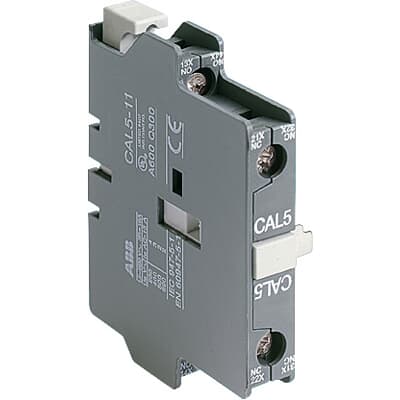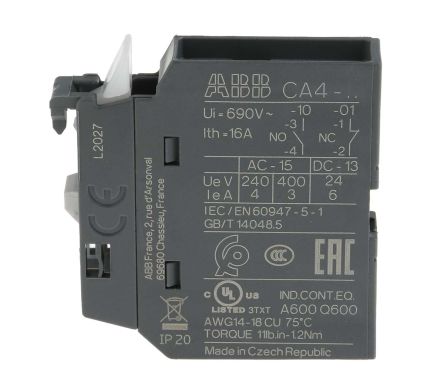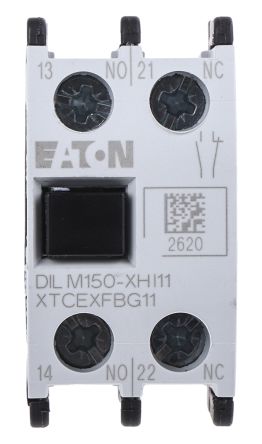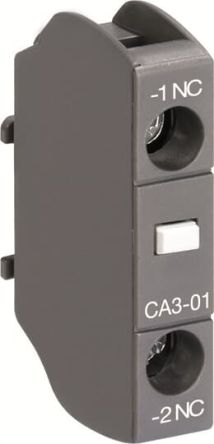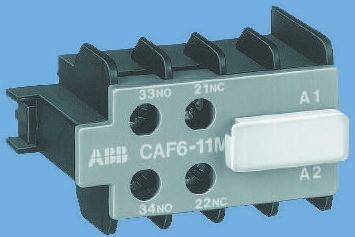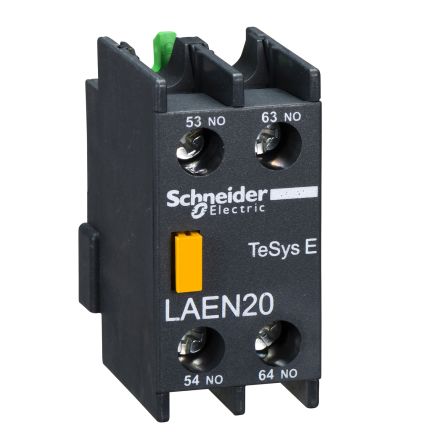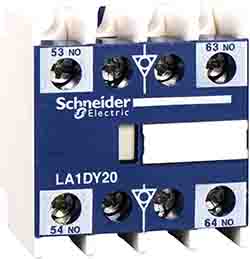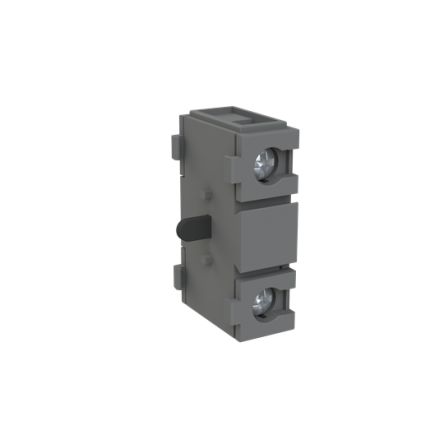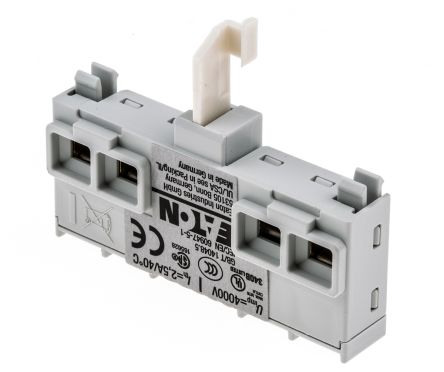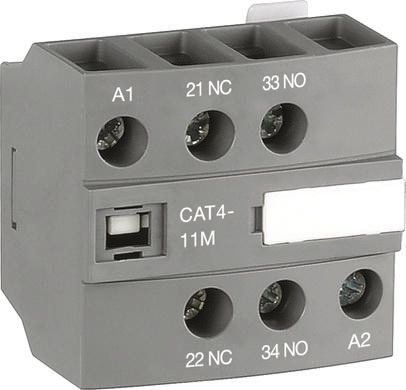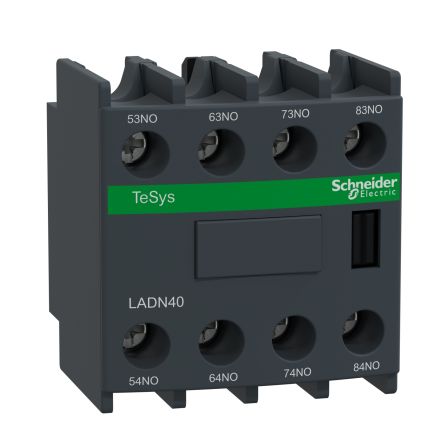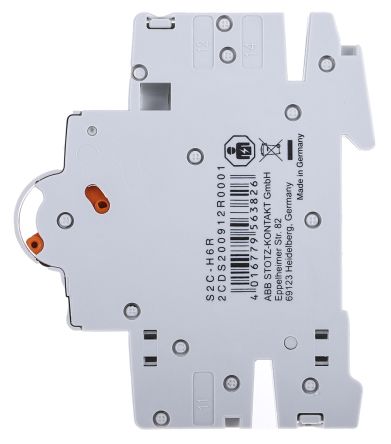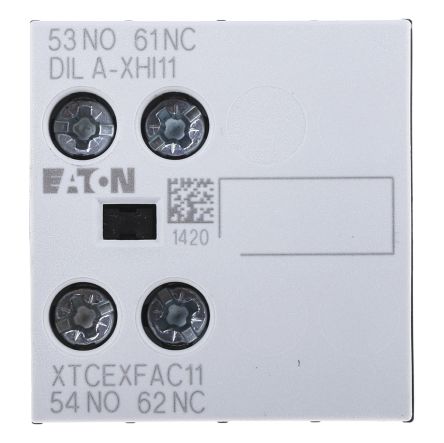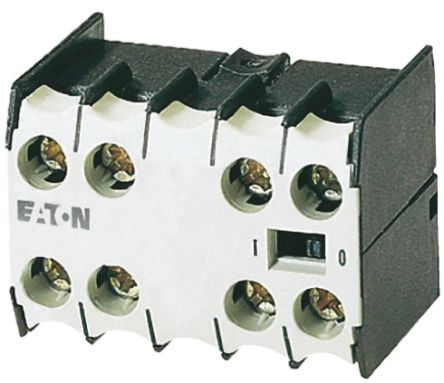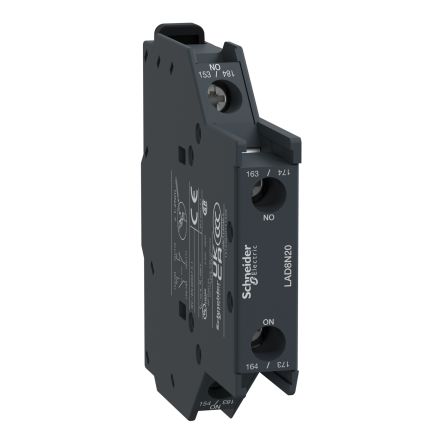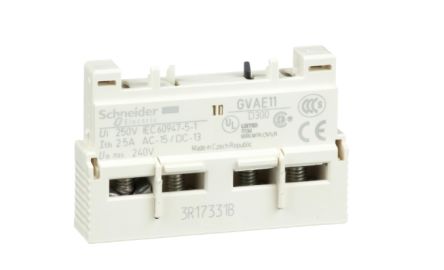- Automation & Control Gear
- Cables & Wires
- Enclosures & Server Racks
- Fuses & Circuit Breakers
- HVAC, Fans & Thermal Management
- Lighting
- Relays & Signal Conditioning
- Switches
- Batteries & Chargers
- Connectors
- Displays & Optoelectronics
- ESD Control, Cleanroom & PCB Prototyping
- Passive Components
- Power Supplies & Transformers
- Raspberry Pi, Arduino, ROCK, STEM Education & Development Tools
- Semiconductors
Auxiliary Contacts
Auxiliary contacts, also known as auxiliary contactors, are electromechanical devices used in conjunction with primary switching equipment such as contactors, circuit breakers, switches, and relays. These secondary switching devices are physically connected to the main switching equipment and work at the same time. The importance of auxiliary contacts lies in their ability to manage additional control functions without interrupting the main power circuit. Unlike main contacts that handle high current, auxiliary contacts are designed for lower current applications and are used to signal, interlock, and control auxiliary circuits.
Aux contacts increase the amount of electricity that can flow through the system by forming part of an auxiliary circuit. They ensure that no single contact point is overloaded by distributing the current across multiple paths, thereby enhancing the system's efficiency and safety. This is crucial in industrial control applications where precise and reliable control is required.
RS offers an extensive range of high-quality auxiliary contact blocks from industry-leading brands including Schneider Electric, Siemens, ABB, Lovato, Eaton, and of course RS Pro. We also offer add-on accessories available in a range of contact configurations and mounting styles to suit a wide range of industrial control applications.
H2 How Auxiliary Contacts Work
Auxiliary contacts are affixed to the main contacts and change state when the main contacts do. They pass the data from the circuit to a logic controller, which in turn gives instructions to the linked devices about whether to turn on or off. Alternatively, they can be used as a standalone hardware control unit.
Auxiliary contacts are available in a variety of mounting styles such as a front mount or DIN rail mount and a range of terminal types including screw terminals, screw clamp terminals, and cage clamp terminals making it easy to find the right contact for the application.
Types of Auxiliary Contactors
Auxiliary contactors come in various types and configurations to suit different industrial control applications. Understanding these types helps in selecting the right aux contacts for your specific needs.
- Mounting Style: Auxiliary contacts are available in various mounting styles, including DIN rail mount, panel mount, and direct mount. These options provide flexibility in installation, ensuring compatibility with different systems.
- Terminal Type: The terminal types for auxiliary contacts include screw terminals, push-in terminals, and spring clamp terminals. Each type offers unique benefits in terms of ease of installation and connection reliability.
- Pole and Throw Configuration: Auxiliary contacts can have different pole and throw configurations such as single pole single throw (SPST), single pole double throw (SPDT), double pole single throw (DPST), and double pole double throw (DPDT). These configurations determine how the contacts operate and control the circuit.
- Contact Material: The materials used for the contacts can vary, with common options including silver, gold, and copper. These materials affect the performance, durability, and conductivity of the auxiliary contacts.
- Current and Voltage Ratings: Auxiliary contacts are designed to handle different current and voltage ratings. It is important to choose a contact that matches the electrical requirements of your application to ensure safe and efficient operation.
- Functionality: Some auxiliary contacts are designed for specific functions such as signalling, interlocking, and safety applications. These specialised contacts enhance the functionality and safety of industrial control systems.
What Are the Different Types of Contact Blocks?
Auxiliary contact blocks are critical components in electrical control systems, providing reliable connection points for aux contacts. They are designed to handle various current and voltage ratings, ensuring consistent performance in industrial environments. These blocks work in conjunction with auxiliary contactors to enhance the functionality and safety of control systems.
There are two types of contact blocks, contacts that are closed in a non-activated state and those that are open. They will be described as N/C (normally closed) and N/O (normally open).NC contacts are used as interlocks. NO contacts are used for switching on other components such as status indication lamps.
Benefits of Contactors with Auxiliary Contacts
Contactors with auxiliary contacts enhance the functionality and safety of electrical systems, making them beneficial for a wide range of industrial and commercial applications.
Enhanced Control: Auxiliary contacts provide additional control points within a circuit, allowing for more precise operation and control of electrical devices. This is especially useful in complex systems where multiple operations need to be managed simultaneously.
Increased Safety: Using auxiliary contactors helps improve safety by providing interlocking functions that prevent accidental operations. Aux contacts can isolate sections of a circuit, reducing the risk of electrical hazards.
Improved Monitoring: Auxiliary contacts allow for better monitoring of electrical systems by providing status signals and feedback. This helps in detecting faults early and ensures timely maintenance, enhancing overall system reliability.
Versatility: Contactors with auxiliary contacts are versatile and can be used in a wide range of applications, from motor control to lighting systems. They can handle various current and voltage ratings, making them suitable for diverse industrial needs.
Space Efficiency: Integrating auxiliary contacts into contactors eliminates the need for additional components, saving space in control panels and auxiliary switchboards for more compact and organised setups.
Industrial Applications of Aux Contacts
Auxiliary contacts are essential components for control and monitoring in various industrial applications. They are commonly used in push-button controllers, where they can be integrated into the start button, as well as in these settings:
- Relay Logic Circuits: Aux contacts are used to implement control logic in relay-based systems, enhancing the functionality of solid-state electronics.
- Electric Motors: They provide additional control points in motor control schemes, improving safety and efficiency.
- Motor Control Schemes: Motor auxiliary contacts are vital for managing the start and stop functions of motors, ensuring smooth operation.
- Industrial Control Applications: Used in various control panels and systems, auxiliary contacts and auxiliary switchboards help monitor and control different industrial processes.
- Push-Button Controllers: Built into start buttons, they offer reliable operation and enhanced control in machinery and equipment.
How to Choose the Right Auxiliary Contact for Your Needs
Here’s what to consider when choosing auxiliary contacts.
First, determine the current and voltage requirements of your application to ensure compatibility. Consider the type of aux contacts needed, such as N/C or N/O, based on the specific control functions.
Assess the environmental conditions, including temperature and humidity, to select contacts with suitable durability. Lastly, look for trusted brands and high-quality products from a reliable auxiliary contacts distributor.
Buying Auxiliary Contacts: Ordering & Delivery
RS is a trusted supplier and distributor of auxiliary contact and contactors from leading brands in Australia. Our range includes brands such as ABB, Schneider Electric, Siemens, and more. To place an order online, simply browse our extensive catalogue, filter your preferred products based on our extensive specifications, and add to your cart.
RS Group offers fast delivery of all types of aux contacts. For more details on delivery services and fees, please refer to our Delivery Page.
Explore the new look of the category page
Popular Searches
Related links
- Schneider Electric Auxiliary Contact Block 2NO TeSys
- Schneider Electric Auxiliary Contact Block 1NC + 1NO TeSys
- Siemens Auxiliary Switch Block 2NC + 2NO Sirius Innovation
- Siemens Auxiliary Contact 2NO + 2NC Sirius Innovation
- Switch Disconnector Auxiliary Contacts
- Siemens Auxiliary Contact
- Socomec Auxiliary Contact
- Schneider Electric - Easy Series Auxiliary Contact 2NO, EasyPact...
